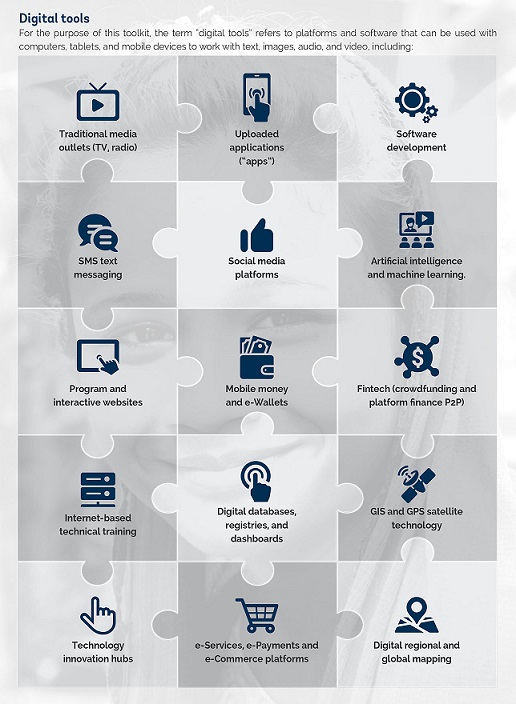Incorporating Technology into Project Design
Does It Make Sense? General Considerations
Minimum Criteria
Digital technology can be transformational, but it must be embedded in sound regulations that ensure affordable Internet access and a competitive business climate; foster accountability that promotes good governance; and set up education systems that support the development of relevant skills that develop future digital leaders. Only then will citizens be able to use technology to leverage the digital economy and harness its full potential for innovation, job creation, and economic transformation.
Access to digital technologies is even more essential in fragile, conflict, and violence (FCV) settings, where gender and social norms are often more restrictive. Women and girls in FCV regions require access to Internet and digital skills as they suffer more mobility restriction, shoulder a greater share of household work and care responsibilities, have less access to resources, such as land and loans, and face more difficulties launching successful businesses and securing quality jobs (Solutions for Youth Employment 2018).
The first two preconditions to a successful digital approach focus on the enabling environment. These will likely be outside the scope of the project, but they nevertheless should be considered.
- A country should have the requisite legal and regulatory framework in place to support ICT sector policy making and regulation to ensure it is built on competitive markets that allow competitive award processes for wireless telecommunications operating licenses, private sector participation, and open access. To avoid users’ fear of prosecution, access should be open and regulations should be transparent so governments do not unduly control or limit content, exclude minority groups, or limit freedom of speech.
- The country or locality should have the necessary physical infrastructure, especially reliable electricity and ICT infrastructure systems, to permit mobile phone use and ensure Internet availability, particularly in rural areas. If the bandwidth is low or Internet access is unavailable in the project location, digital tools may be limited to SMS texting and other simple technologies.
- The next preconditions reflect beneficiaries’ localized enabling environments:
- If there is adequate Internet availability, it must also be sufficiently affordable and accessible to the target beneficiary group. Accessibility can be related to cost, mobility, awareness, literacy, and restrictive gender norms. If accessibility is significantly limited, there is little benefit to incorporating the technology in the intervention. For example, many people in India believe giving women access to cell phones before marriage discourages abstinence and after marriage may lead to the neglect of husbands and children. (Barboni et al. 2018).

The last two preconditions reflect beneficiaries’ localized enabling environments and are more within the project team’s ability to address through project design:
- The tool selected should reflect the capabilities of the beneficiary group. If their knowledge of the technology required is low or nonexistent, the project design should include support from technical specialists who can train and support the beneficiaries in its use. The tool should also be designed in such a way as to increase intuitive use and uptake, for example by incorporating voice, pictures, or other approaches to support adoption.
- Design efforts should consider whether the tool is accessible for the beneficiaries, and if not, whether a central facility, such as a community center or library, will be reliably available to and accessible by women.
Secure Digital Financial Data Protection Systems
Deploying technology used in digital financial services requires establishing and maintaining appropriate processes, including both public and private entities’ processes for collecting, storing, processing, and exchanging customer data.
Businesses and individuals who use digital financial services run the risk of the unauthorized disclosure and use of their data for fraudulent purposes; cyberattacks; system failures; and overreliance on third-party service providers for cloud storage and analytics as well as data provisioning to create, prepare, and enable networks to provide data to users (World Bank Group 2020b).
WSMEs can be especially vulnerable to criminal activity as they often have less experience with formal financial services and financial management (Bill and Melinda Gates Foundation 2019).
Rigorous data protection systems are vital to prevent consumer fraud and support secure use of digital financial tools and to build trust in the use of financial services by governments, businesses, and individuals. Data protection considerations apply to both governments and the private sector and should be balanced with objectives linked to transparency, innovation, and competition.
Rigorous Government Data Protection Systems
Risks that can be mitigated with strong data governance frameworks at the national or subnational level should be evaluated within the project’s country context. For example, digital IDs can facilitate a project’s access to finance component but implementing them requires governments to store large quantities of personal data about individuals.
This is true as well for national electronic registries with data inventories of collateral and property ownership. Proper governmental regulations and adequate technology are essential to preventing misuse by establishing robust security measures around data access. Weak data governance and confidentiality systems can lead to accidental data loss and intentional data theft, with serious consequences, and will lead to mistrust of the technology among both individuals and government institutions.
Sound Private Sector Data Governance
It is also essential that businesses operate with confidence while using digital technologies. Digital governance must include strong regulations and supervisory frameworks that protect digital financial services users, including women.
Studies indicate that, in comparison to men, women tend to have a lower awareness of digital financial services and less advanced technological devices; they thus have limited access to multiple financial services options (Chamboko, Heitmann, and Van Der Westhuizen 2018).
In addition, women experience new forms of gender-based violence, abuse, and harassment through digital means (Bill and Melinda Gates Foundation 2019), and they may lack the training, skills, and knowledge needed to protect themselves and their digital data.



